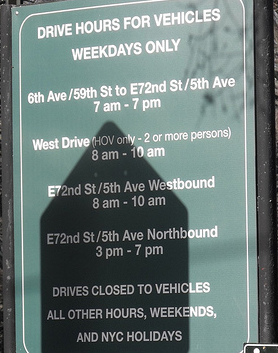JSK’s “98 Percent” Car-Free Central Park Claim Is 100 Percent Wrong
DOT Commissioner Janette Sadik-Khan appeared on WNYC’s Brian Lehrer Show last Wednesday to talk about the agency’s plans to, as Lehrer put it, "spread the Times Square model." When Lehrer invited listeners to call in with their ideas for other streets that should be made car-free zones, "Steve from Manhattan" asked why the Central Park loop wasn’t being closed to traffic, calling it "obvious" and a "no-brainer." In her response, the commissioner said that Central Park’s loop road already is closed to traffic "98 percent of the time."
 Photo: bicyclesonly/Flickr
Photo: bicyclesonly/FlickrIf this were true, it would invite the question why it’s such a big deal to finish the job, but in fact Sadik-Khan’s statistic is simply false. Worse, she’s clearly been using this inaccurate figure for quite some time, because she also cited it in a conversation I had with her back in October 2008.
Here are the facts: Because different sections of the loop are open to traffic for different lengths of time, the actual percentage depends on where you are on the loop and also on what you define as "the time" (for example, is it every hour of every day or only the hours when people are actually in the park?). Given this, the actual percentage of time that cars are banned ranges from a low of 25 percent to a high of 94 percent, depending where you are on the loop.
Let’s assume that "the time" means every hour of every day. With the West Drive now open to traffic for only two hours on weekday mornings, it’s closed to traffic 94 percent of "the time," which is the likely source of Sadik-Khan’s "98 percent." But as any recreational user of Central Park knows, the six-mile loop has an East Drive as well, which is open to traffic far longer. The East Drive north of 72nd Street is open from 3 p.m. to 7 p.m., and the half-mile segment between the Sixth Avenue entrance and the E. 72nd Street exit permits vehicular access from morning until night, 7 a.m. to 7 p.m. This means the section north of 72nd is closed to traffic 88 percent of "the time" and the southern section is closed only 64 percent of "the time."
The percentage of car-free time drops if we limit "the time" to weekday hours when people are actually likely to be in the park, and exclude weekends (when cars have been banned for 43 years), the overnight curfew (when no one is allowed in the park anyway), and the period from 10 p.m. to the curfews’ start at 1 a.m. If "the time" is instead defined as weekdays from 6 a.m. to 10 p.m., the West Drive is closed to traffic 87 percent of the time, the northern part of the East Drive is closed 77 percent of the time, and the southern section is closed only one quarter of the time.
Whatever the percentages are, the fact remains that the drives are open to traffic during the precise hours when non-motorized use is highest: before the start of the workday on the West Drive; when kids are getting out of school and adults off from work on the northern section of the East Drive; and virtually all day on the East Drive’s southern corner. The commissioner’s implicit assertion that the park is almost completely closed to traffic is highly misleading and unhelpful.
On the more hopeful side, Sadik-Khan told Lehrer that closing the park to cars is "something we’ve been looking at," but she hastened to add that "it’s a balancing act in terms of understanding how the traffic flows through this important part of the city."
One wonders how much more data DOT needs before its understanding is complete. Over the past two decades the agency has repeatedly installed traffic counters both in the park and on surrounding streets. After each of its major adjustments to car access it has conducted detailed studies, none of which found any significant traffic problems. Isn’t it time DOT heeded the advice that urbanist Jane Jacobs offered me in a letter from 2002?
We had the same sort of fight in Washington Square Park in the late 1950s and in my neighborhood here in Toronto a couple of years ago: same prediction of traffic chaos, same result of no chaos, diminished traffic counts and no counts increased elsewhere in consequence. Isn’t it curious that traffic engineers are so loath to learn something new even after repeated demonstrations? Both in Washington Square Park and in my Toronto neighborhood we got our way by pressing for an experimental trial period. A trial, with traffic counts on the Central Park perimeter streets, will be more persuasive than any amount of talk, letter-writing, resolutions, and other endless wheel-spinning.





